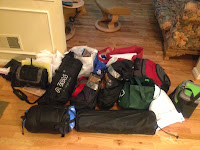Running the C & O

With March's Graveyard 100 casting a lengthy backwards shadow over my winter training, I've been seeking out extended flat runs to ready myself for this test along the Outer Banks of North Carolina. Dead-level running hour after repetitive hour poses special challenges, mental and physical. I am fortunate to live close to the perfect venue for this sort of exercise: the C & O Canal Towpath, 184 magnificent miles along the Potomac, from Georgetown to Cumberland, MD. Last Saturday's plan was to sample 36 of those miles, starting at the Dickerson Conservation Park, a little north of my usual starting point at Riley's Lock or Carderock. My hope was to keep above the snow/sleet line that tends to snake unpredictably across the middle of our state, and so avoid any hypothermia-inducing cold rain. There was also the excitement of a running a portion of the path I haven't seen before. Pulling out of Dickerson, I am slapped first by a hissing sleet. ...





